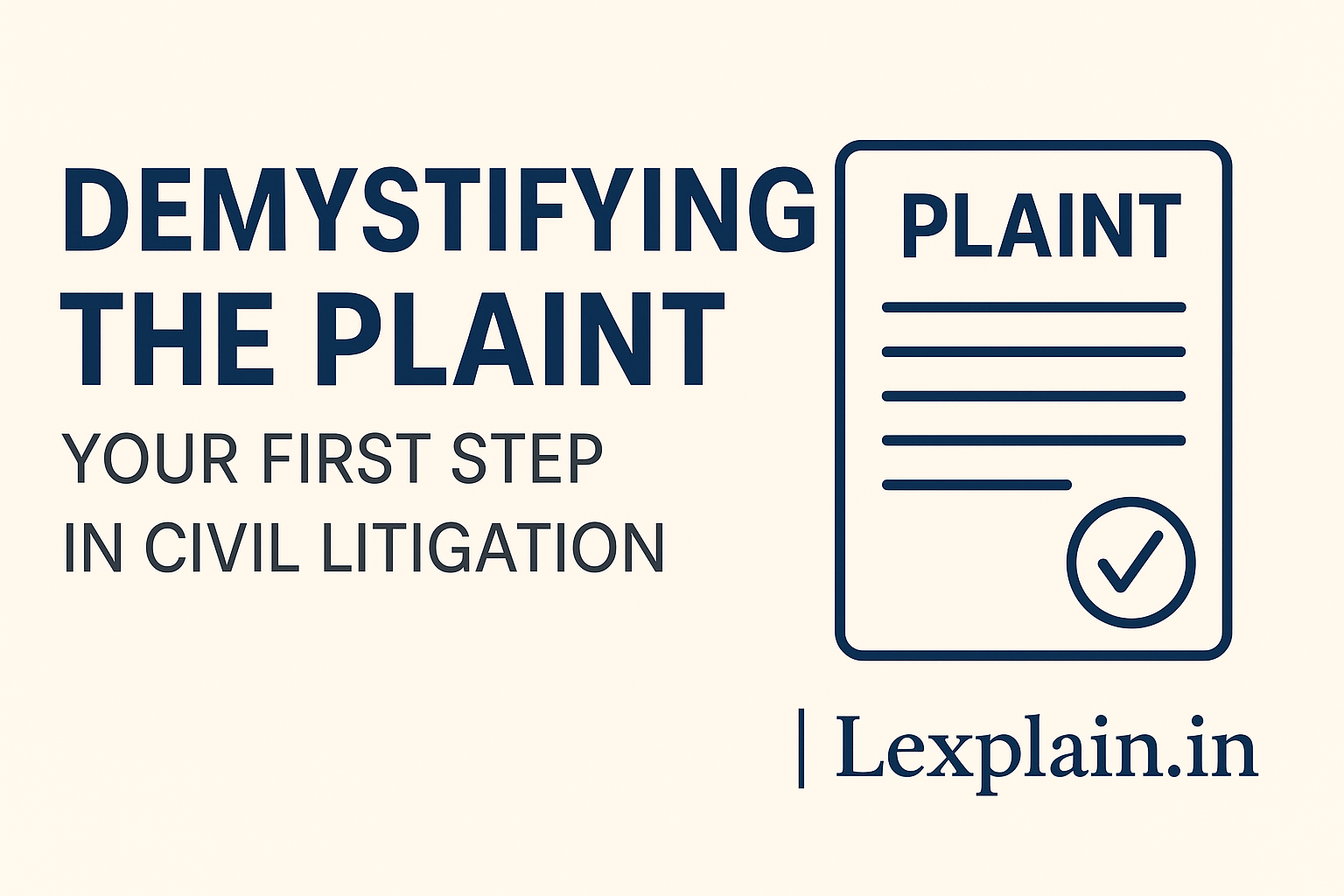Have you ever wondered how a legal dispute officially begins in a civil court?
It all starts with a powerful document known as the plaint. For law students and budding lawyers, understanding what a plaint is—and how it operates within the broader civil justice system—is essential. It’s not just paperwork; it’s the formal key that unlocks the door to civil litigation.
In this blog post, we’ll walk you through what a plaint really is, what it must contain as per Indian law, and how the court processes it. Whether you’re studying for exams or gearing up for your legal career, this guide will serve as your go-to primer on plaints.
- What is a Plaint? — The Starting Point of a Civil Suit
- What Should a Plaint Contain? (Order VII, Rule 1 CPC)
- ✅ The Verification Clause: Truth Under Oath
- 📥 How a Plaint Gets Admitted in Court
- ❌ When Can the Court Reject a Plaint? (Order VII, Rule 11 CPC)
- 🎓 Tips for Law Students: Master the Art of Drafting a Plaint
- 🧭 Conclusion: The Blueprint of Civil Justice
What is a Plaint? — The Starting Point of a Civil Suit
At its essence, a plaint is the first formal pleading submitted by a plaintiff (the person who initiates the case) to the court to begin a civil suit. It’s like the plaintiff’s official complaint, narrating the facts of the dispute and the specific legal remedy they’re seeking.
Though the Code of Civil Procedure, 1908 (CPC) does not define “plaint” in exact words, it is widely accepted as the document that initiates civil proceedings. It lays out the plaintiff’s version of the facts, the legal foundation for their claim, and the relief they want the court to provide.
Why is the Plaint So Important?
- ✅ Initiates Legal Proceedings: A civil suit cannot begin without a plaint.
- ✅ Defines the Dispute: It outlines the facts and legal issues involved.
- ✅ Frames the Evidence: Determines what facts and documents will be relevant in court.
- ✅ Guides the Defendant’s Reply: The defendant prepares a Written Statement in response to the plaint.
📌 Note: A “plaint” is not the same as a “suit.” The plaint is just the beginning; the suit is the full legal process that follows.
What Should a Plaint Contain? (Order VII, Rule 1 CPC)
Drafting a plaint is a technical task governed by Order VII, Rule 1 of the CPC. It prescribes what must be included to make a plaint valid.
🧾 I. Basic Details – The ‘Who, What, Where’
- Name of the Court
Clearly mention the court where the suit is filed.
E.g., “In the Court of Civil Judge (Senior Division), Latur” - Details of the Plaintiff
- Full name
- Description (age, occupation, father’s name, etc.)
- Address
- Details of the Defendant
Same information as above — accurate identification is key for serving summons. - Minor or Unsound Mind
If any party is a minor or mentally unfit, it must be disclosed. A next friend or guardian ad litem must represent them. - Facts Constituting the Cause of Action
This is the heart of the plaint — the legal and factual reasons why the plaintiff is suing.
➤ Also mention when the cause of action arose (to check if it’s within the limitation period). - Jurisdiction of the Court
The plaint must establish that the court has:- Territorial jurisdiction: Based on location
- Pecuniary jurisdiction: Based on monetary value
- Subject-matter jurisdiction: Based on type of dispute
- Relief Sought
Clearly state what the plaintiff wants—money, property, injunction, specific performance, etc. - Amount Relinquished or Received (if any)
If any part of the claim is waived or settled, mention it. - Valuation of the Suit
This is used for:- Deciding if the court has pecuniary jurisdiction
- Calculating court fees
📝 II. Special Cases under Order VII Rules
- Suits for Money (Rule 2)
State the exact amount claimed, or a close estimate if uncertain. - Suits for Immovable Property (Rule 3)
Include precise property details like survey numbers, boundaries, etc. - Representative Suits (Rule 4)
If one person sues on behalf of many, show the common interest and legal authority. - Exemption from Limitation (Rule 6)
If the suit is filed late, explain why the delay should be excused (e.g., fraud, part payment, etc.). - Defendant’s Role (Rule 7)
Show how the defendant is connected to the dispute and why they are responsible.
✅ The Verification Clause: Truth Under Oath
Every plaint must be verified by the plaintiff. This section confirms that the facts stated are true to the best of the plaintiff’s knowledge or belief. The plaint must be signed and dated—this is essential for its legal validity.
📥 How a Plaint Gets Admitted in Court
The plaint doesn’t just go to court and magically start a case. Here’s how it is processed:
1. Filing the Plaint
The plaintiff or their advocate files the plaint with the court office.
2. Initial Scrutiny by Court Staff (Sheristadar/Nazir)
They check for:
- Formatting and paper rules
- Correct court fees
- Proper stamping of attached documents
- Jurisdiction and limitation
3. Correction of Defects
If errors are found, the plaintiff is asked to fix them. Failure to do so can result in rejection.
4. Admission of Plaint
Once everything is in order, the court admits the plaint—meaning the case is officially accepted.
5. Issuance of Summons (Order V, Rule 9)
The plaintiff must provide:
- Copies of the plaint for each defendant
- Process fees for issuing summons
The court then sends formal notices to the defendant(s) to appear and file a Written Statement.
❌ When Can the Court Reject a Plaint? (Order VII, Rule 11 CPC)
Even before trial begins, the court can reject the plaint if it falls short on key grounds:
- No Cause of Action
If the plaint doesn’t show any legal wrong, it will be dismissed. - Incorrect Valuation
Relief undervalued and plaintiff doesn’t correct it in time. - Insufficient Stamp Duty
If stamp paper isn’t adequate and not corrected in time. - Suit is Barred by Law
E.g., limitation expired or legally not maintainable. - Missing Copies or Process Fees
Failure to file required copies or pay process fees.
📌 Important: Rejection under Rule 11 doesn’t stop the plaintiff from filing a fresh plaint on the same cause of action, if still within the limitation period.
🎓 Tips for Law Students: Master the Art of Drafting a Plaint
- 📚 Read Order VII Carefully: Know the rulebook inside out.
- 🔍 Analyze Model Plaints: Learn from well-drafted examples.
- 🧠 Focus on Material Facts: Only plead essential facts—not evidence.
- 🧾 Clarity is Crucial: Be precise and legally sound.
- 📌 Understand Jurisdiction: It decides where your plaint is filed.
- ✍️ Practice Drafting: Use hypotheticals to hone your drafting skills.
- 🙏 Draft a Proper Prayer Clause: Be clear on what remedy you seek.
🧭 Conclusion: The Blueprint of Civil Justice
A plaint may appear like just another legal document, but in truth, it’s the blueprint of civil litigation. It defines the entire course of the case. For any aspiring lawyer, learning how to read, understand, and draft a plaint is an essential skill.
By grasping the fundamentals of what a plaint is, what it should contain, and how it’s processed, you’re laying down the first brick in your legal career. So keep learning, stay curious, and remember — every courtroom battle begins with a plaint!


Pingback: Understanding Injunction and Temporary injunction : your Student-Friendly Guide to Order 39 of CPC - lexplain.in
Pingback: Arrest & Attachment Before Judgment CPC: A Student's Essential Guide